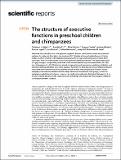Files in this item
The structure of executive functions in preschool children and chimpanzees
Item metadata
| dc.contributor.author | Voelter, Christoph J. | |
| dc.contributor.author | Reindl, Eva | |
| dc.contributor.author | Felsche, Elisa | |
| dc.contributor.author | Civelek, Zeynep | |
| dc.contributor.author | Whalen, Andrew | |
| dc.contributor.author | Lugosi, Zsuzsa | |
| dc.contributor.author | Duncan, Lisa | |
| dc.contributor.author | Hermann, Esther | |
| dc.contributor.author | Call, Josep | |
| dc.contributor.author | Seed, Amanda M. | |
| dc.date.accessioned | 2022-04-20T12:30:04Z | |
| dc.date.available | 2022-04-20T12:30:04Z | |
| dc.date.issued | 2022-04-19 | |
| dc.identifier | 277844496 | |
| dc.identifier | 8d2076d0-d2ac-4e5d-a80f-9da116be2393 | |
| dc.identifier | 000783915800062 | |
| dc.identifier | 85128485332 | |
| dc.identifier.citation | Voelter , C J , Reindl , E , Felsche , E , Civelek , Z , Whalen , A , Lugosi , Z , Duncan , L , Hermann , E , Call , J & Seed , A M 2022 , ' The structure of executive functions in preschool children and chimpanzees ' , Scientific Reports , vol. 12 , 6456 . https://doi.org/10.1038/s41598-022-08406-7 | en |
| dc.identifier.issn | 2045-2322 | |
| dc.identifier.other | ORCID: /0000-0002-3867-3003/work/111971365 | |
| dc.identifier.other | ORCID: /0000-0002-8597-8336/work/111973903 | |
| dc.identifier.uri | https://hdl.handle.net/10023/25216 | |
| dc.description | Funding: The research of A.M.S. was supported by an ‘INQMINDS’ ERC Starting Grant no. (SEP-210159400). | en |
| dc.description.abstract | Executive functions (EF) are a core aspect of cognition. Research with adult humans has produced evidence for unity and diversity in the structure of EF. Studies with preschoolers favour a 1-factor model, in which variation in EF tasks is best explained by a single underlying trait on which all EF tasks load. How EF are structured in nonhuman primates remains unknown. This study starts to fill this gap through a comparative, multi-trait multi-method test battery with preschoolers (N = 185) and chimpanzees (N = 55). The battery aimed at measuring working memory updating, inhibition, and attention shifting with three non-verbal tasks per function. For both species the correlations between tasks were low to moderate and not confined to tasks within the same putative function. Factor analyses produced some evidence for the unity of executive functions in both groups, in that our analyses revealed shared variance. However, we could not conclusively distinguish between 1-, 2- or 3-factor models. We discuss the implications of our findings with respect to the ecological validity of current psychometric research. | |
| dc.format.extent | 2064214 | |
| dc.language.iso | eng | |
| dc.relation.ispartof | Scientific Reports | en |
| dc.subject | Executive functions | en |
| dc.subject | Working memory | en |
| dc.subject | Attention shifting | en |
| dc.subject | Inhibition | en |
| dc.subject | Comparative cognition | en |
| dc.subject | Primate cognition | en |
| dc.subject | Child development | en |
| dc.subject | BF Psychology | en |
| dc.subject | RC0321 Neuroscience. Biological psychiatry. Neuropsychiatry | en |
| dc.subject | DAS | en |
| dc.subject.lcc | BF | en |
| dc.subject.lcc | RC0321 | en |
| dc.title | The structure of executive functions in preschool children and chimpanzees | en |
| dc.type | Journal article | en |
| dc.contributor.sponsor | European Research Council | en |
| dc.contributor.institution | University of St Andrews. School of Psychology and Neuroscience | en |
| dc.contributor.institution | University of St Andrews. Centre for Social Learning & Cognitive Evolution | en |
| dc.contributor.institution | University of St Andrews. ‘Living Links to Human Evolution’ Research Centre | en |
| dc.contributor.institution | University of St Andrews. Institute of Behavioural and Neural Sciences | en |
| dc.identifier.doi | 10.1038/s41598-022-08406-7 | |
| dc.description.status | Peer reviewed | en |
| dc.identifier.grantnumber | 639072 | en |
This item appears in the following Collection(s)
Items in the St Andrews Research Repository are protected by copyright, with all rights reserved, unless otherwise indicated.

